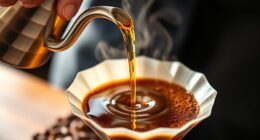To make the perfect cappuccino, aim for a balanced mix of about one-third espresso, one-third steamed milk, and one-third dense microfoam. This ratio guarantees a rich flavor, creamy texture, and appealing visual contrast. Properly steaming your milk and creating fine microfoam are key steps. Getting this harmony takes practice, and mastering it can elevate your coffee experience—if you keep exploring, you’ll uncover even more tips to perfect your cappuccino.
Key Takeaways
- Aim for equal parts: approximately 1/3 espresso, 1/3 steamed milk, and 1/3 foam for balance.
- Use a well-pulled espresso shot to provide a strong, concentrated flavor base.
- Steam milk to a velvety texture, ensuring it complements the espresso without overpowering it.
- Create dense microfoam with tiny bubbles, forming a stable layer about one-third of the drink’s volume.
- Practice precise pouring and ratios to achieve harmony, visual appeal, and a satisfying flavor profile.

A perfect cappuccino depends on getting the right ratio of espresso, steamed milk, and foam. When you’re aiming for that ideal balance, it all starts with a well-pulled espresso shot. This shot forms the foundation of your drink, delivering the bold, rich flavor that defines a cappuccino. The espresso should be strong and concentrated, providing a robust base that complements the creaminess of the milk. Once you have your espresso shot, the next step is adding steamed milk, which should be heated to a velvety texture. The milk acts as a smooth bridge between the espresso and the foam, softening the intensity while enhancing the overall creaminess. The key is to pour enough steamed milk to balance the espresso’s strength without overpowering it.
The final component that makes or breaks your cappuccino is the milk foam. This foam isn’t just a topping; it’s an integral part of the drink’s structure. You want to create a dense, microfoam with tiny, uniform bubbles that sit atop the steamed milk. The milk foam should be thick enough to hold its shape, yet light enough to add a silky texture to every sip. When you pour the foam over the espresso and steamed milk, aim for a ratio where about one-third of your drink is foam, one-third is steamed milk, and one-third is espresso. This classic proportion ensures that none of the elements overpower the others, creating a harmonious blend of flavors and textures.
Getting the ratio right requires a bit of practice, but once you master it, you’ll notice how much more balanced and enjoyable your cappuccinos become. If you add too much foam, the drink feels airy and less flavorful; too little, and it lacks the signature creaminess and visual appeal. Similarly, if the espresso shot isn’t strong enough or is over-extracted, the entire drink can taste flat or bitter. The art is in balancing these components to enhance each other perfectly. Remember, a good cappuccino isn’t just about the ingredients but about how they come together in the right proportions. With attention to detail and a little practice, you’ll consistently craft cappuccinos that are both delicious and visually appealing.
Frequently Asked Questions
How Does Altitude Affect the Perfect Cappuccino Ratio?
At high altitude, brewing can be tricky because of lower boiling points and pressure changes. You should make high altitude adjustments by slightly increasing the espresso dose and steaming milk longer to compensate for the thinner air. These adjustments help maintain the perfect cappuccino ratio, ensuring your espresso remains rich and the milk froth stays creamy, despite the altitude differences. Always experiment a bit to find what works best in your environment.
Can Different Coffee Bean Types Alter the Ideal Ratio?
Imagine each coffee bean variety and roasting level as artists with unique palettes. They can definitely alter your ideal cappuccino ratio because different beans and roasts produce varying espresso strengths and flavors. Light roasts may need a touch more milk to balance brightness, while darker roasts can handle less. You’ll want to adjust your ratio based on the beans’ characteristics, ensuring every sip highlights their distinct artistry.
What’s the Best Way to Measure Foam Consistency?
To measure foam consistency, focus on your milk frothing technique to achieve the right foam texture. You can gently tap the frothing pitcher on a counter to remove large bubbles and swirl it to even out the texture. The foam should be smooth, velvety, and glossy, with tiny bubbles. When you tilt the pitcher, the foam should hold its shape without collapsing, ensuring a perfect cappuccino.
How Does Temperature Influence the Cappuccino Balance?
Think of your cappuccino as a delicate dance; milk temperature sets the rhythm. When milk is too hot, it scorches flavor extraction, making the drink bitter and unbalanced. If it’s too cold, the milk won’t blend smoothly, dulling the overall harmony. Aim for warm milk, around 150°F, to guarantee the espresso’s flavors shine through, creating a well-balanced, flavorful cappuccino that’s perfectly in tune.
Are There Regional Variations in Traditional Cappuccino Ratios?
You’ll find regional variations in traditional cappuccino ratios driven by cultural influences and local preferences. For instance, Italian cafes often stick to a classic 1:1:1 ratio of espresso, milk, and foam, emphasizing balance. In contrast, some countries prefer more milk for creaminess, while others favor a thicker foam layer. These differences reflect local tastes and customs, making each region’s cappuccino unique and tailored to its cultural palate.
Conclusion
Now that you know the perfect balance of espresso, milk, and foam, you can craft a cappuccino that’s as harmonious as a symphony. Think of the ratio as the key to revealing flavor and texture, turning each sip into a cozy cloud of comfort. With this knowledge, you’re ready to create a drink that’s both art and science—an inviting masterpiece that beckons you to take another sip and enjoy the delightful dance of ingredients.









